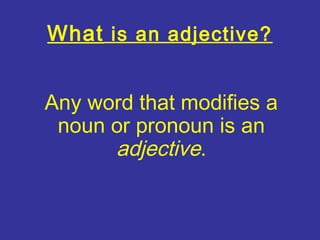Adjective
- 1. What is an adjective? Any word that modifies a noun or pronoun is an adjective.
- 2. Important Considerations In general, adjectives usually appear before the noun they modify or after a linking verb.  For example: "That is a red ball" (adjective before the noun) or "That ball is red" (adjective after the linking verb)
- 3. The following are the twelve major categories of meaning that are expressed with English adjectives
- 4. 1. COLOR: blue, red, green, brown, yellow, black, white, etc. 2. SIZE: big, small, little, long, tall, short, same as, 3. SHAPE: round, circle, triangle, rectangle, square, oval, 4. DISTANCE: long, short, far, around, start, high, low,
- 5. 5. FEELINGS OR QUALITIES: good, pretty, right, good, old, better, best, full, funny, light, clean, new, fast, happy, sad, crooked, straight, noisy, quiet, full, empty, fast, slow, closed, open, soft, hard 6. QUANTITY: one, two, three, four, five, six, seven, eight, ten, many, few, all, some, every, any, first, once, much, 7. TEMPERATURE: cold, warm, hot, cool, 8. TIME: late, early, bed, nap, dinner, lunch, day, morning, night,
- 6. 9. NATIONALITY or ORIGIN: American, Mexican, 10.MATERIAL: wooden, sharp, paper, cloth, 11.AGE: new, old, young, child, adult, baby, teenage, 12.PURPOSE: sleeping bag, frying pan, swinging door.
- 8. Descriptive Adjective (Adjective of Quality) • This is used to describe height, length, width, age, shape, colour, origin, purpose, condition/ability/opinion and material. • Examples: good, beautiful, young, blue, straight, deep, loud, plain. • How are descriptive adjectives used? - Right before the noun. • That is beautiful picture. - After the verb ‘to be’ (is, are, was, were). • My father’s car is red in colour. - After verbs such as get, look, seem, feel, smell, taste, sound, become and appear. • It looks good to me.
- 9. Quantitative Adjective (Adjective of Quantity) • This adjective takes care of numbers and amounts. This one helps you know how many people, animals, things or place are being described. Where uncountable (things that cannot be counted) are involved, quantitative adjectives will be of great help in telling you how much is being measured. • Examples: some, any, no, much, many, more, most, enough, (a) little, less, least, a few, fewer, fewest, several, all, half, other, one, two, three, ten, twenty etc. • How are quantitative adjective used? – Written before the noun. • Some girls in this school can speak Thai. • Most people in this fishing village are rich. • There were a few bats in my room last night.









